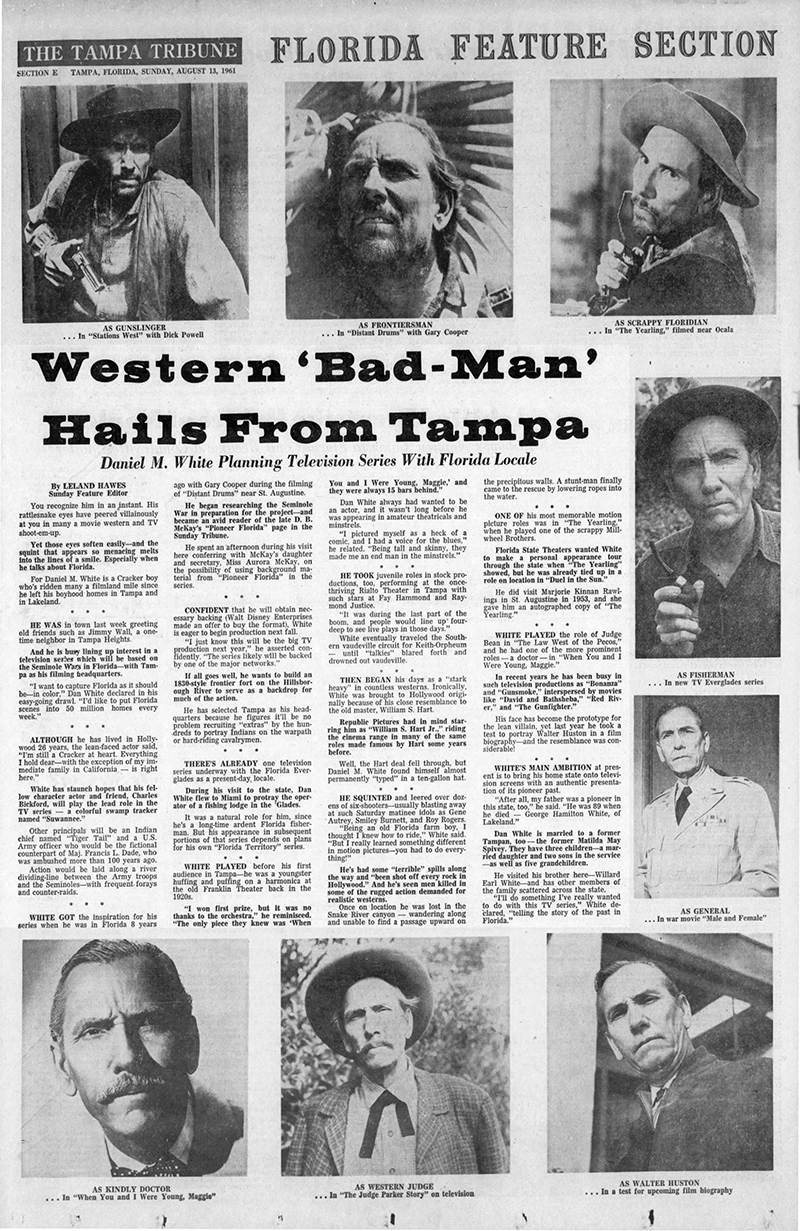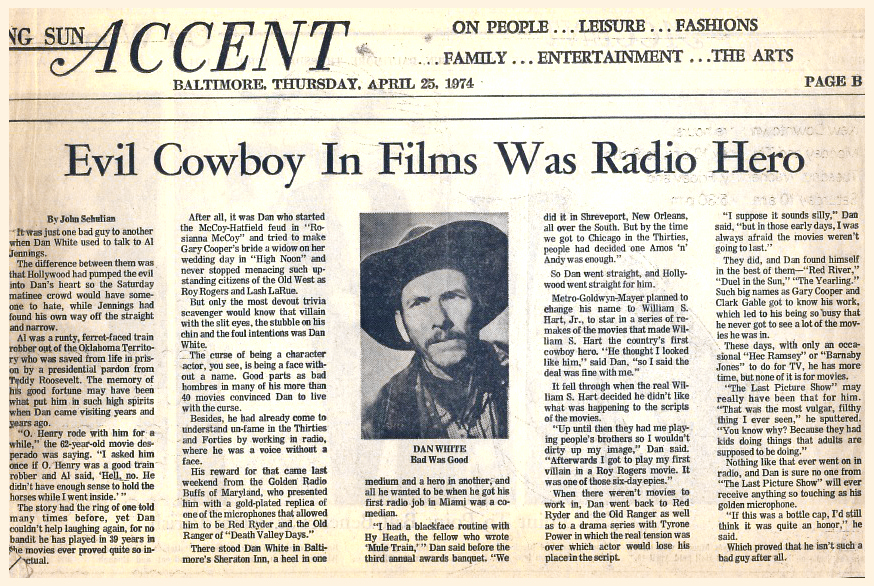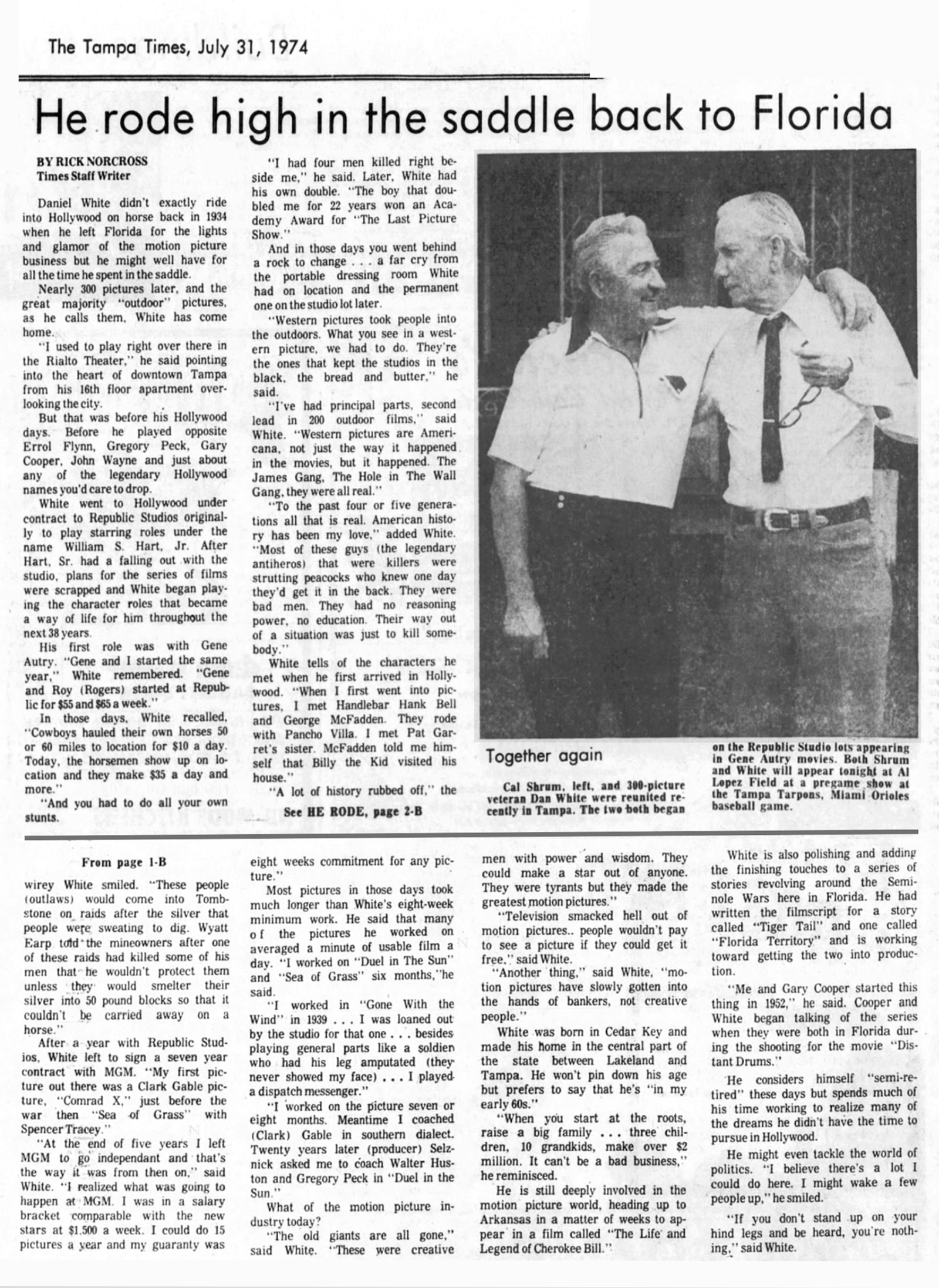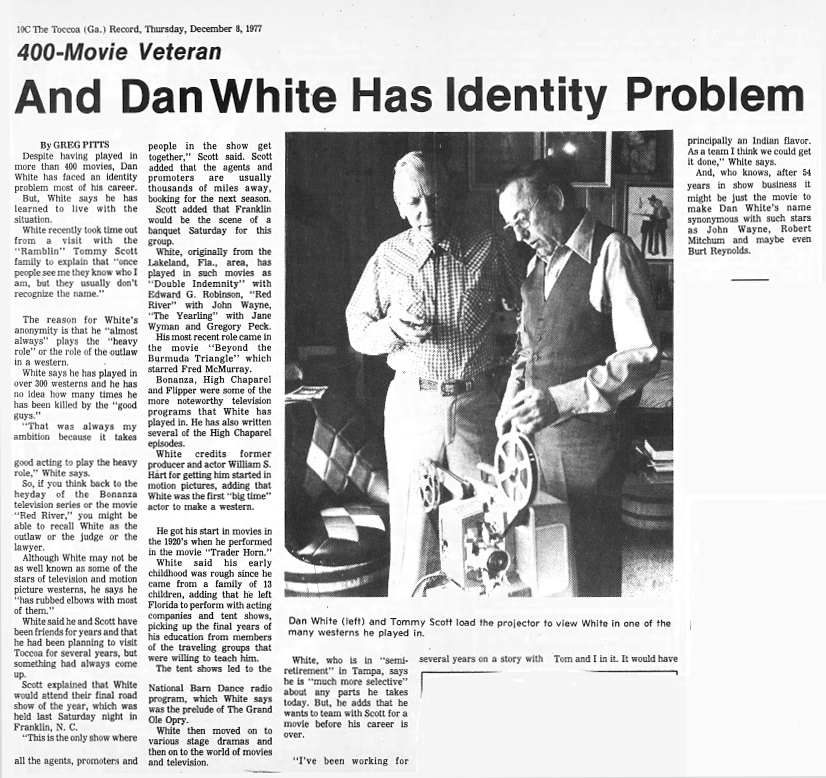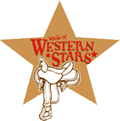|
|

Dan White, Character Actor.
News Features, 1961-1977.
|
Webmaster's note.
Daniel M. "Dan" White (1908-1980) was a character actor who appeared in more than 400 films and TV shows, of which dozens used Santa Clarita Valley locations — from 1944's "Voodoo Man" with Bela Lugosi to 1954's "Suddenly" with Frank Sinatra and many more before and after. Audiences knew his face if not his name — the bane of many a character actor. White credited Bill Hart with his entry in to the movie business in the late 1920s. In fact, according to published reports, since White somewhat resembled Hart in appearance, Republic intended to give him the screen name of "William S. Hart Jr." to capitalize on the two-gun man's legend. The reaction from the latter is almost palpable, considering, first, that Hart wasn't ready to give up his acting career when he was shoved off of the screen, and two, he had a young son by that name. Regardless, White and Hart became friends, evidence of which is seen in a 1944-45 photograph at Hart's estate in Newhall. White's son was an original owner in the Princess tract in Newhall, and the elder White often brought his grandchildren to visit film locations such as Melody Ranch. His grandson, Johnny White, remembers that Dan lived with the family in Newhall when Johnny was a youngster. One footnote of local interest: Dan White's daughter-in-law, Dee White, later owned the Big Oaks Lodge in Bouquet Canyon.
Western 'Bad Man' Hails from Tampa. Daniel M. White Planning Television Series with Florida Locale. The Tampa Tribune | Sunday, August 31, 1961. You recognize him in an instant. His rattlesnake eyes have peered villainously at you in many a movie western and TV shoot-em-up. Yet those eyes soften easily — and the squint that appears so menacing melts into the lines of a smile. Especially when he talks about Florida. For Daniel M. White is a Cracker boy who's ridden many a filmland mile since he left his boyhood homes in Tampa and in Lakeland. He was in town last week greeting old friends such as Jimmy Wall, a onetime neighbor in Tampa Heights. And he is busy lining up interest in a television series which will be based on the Seminole Wars in Florida — with Tampa as his filming headquarters. "I want to capture Florida as it should be — in color," Dan White declared in his easy-going drawl. "I'd like to put Florida scenes into 50 million homes every week." Although he has lived in Hollywood 26 years, the lean-faced actor said, "I'm still a Cracker at heart. Everything I hold dear — with the exception of my immediate family in California — is right here." White has staunch hopes that his fellow character actor and friend, Charles Bickford, will play the lead role in the TV series — a colorful swamp tracker named "Suwannee." Other principals will be an Indian chief named "Tiger Tail" and a U.S. Army officer who would be the fictional counterpart of Maj. Francis L. Dade, who was ambushed more than 100 years ago. Action would be laid along a river dividing-line between the Army troops and the Seminoles — with frequent forays and counter-raids. White got the inspiration for his series when he was in Florida eight years ago with Gary Cooper during the filming of "Distant Drums" near St. Augustine. He began researching the Seminole War in preparation for the project — and became an avid reader of the late D.B. McKay's "Pioneer Florida'' page in the Sunday Tribune. He spent an afternoon during his visit here conferring with McKay's daughter and secretary, Miss Aurora McKay, on the possibility of using background material from "Pioneer Florida" in the series. Confident that he will obtain necessary backing (Walt Disney Enterprises made an offer to buy the format), White is eager to begin production next fall. "I just know this will be the big TV production next year," he asserted confidently. "The series likely will be backed by one of the major networks." If all goes well, he wants to build an 1830-style frontier fort on the Hillsborough River to serve as a backdrop for much of the action. He has selected Tampa as his headquarters because he figures it'll be no problem recruiting "extras" by the hundreds to portray Indians on the warpath or hard-riding cavalrymen. There's already one television series underway with the Florida Everglades as a present-day locale. During his visit to the state, Dan White flew to Miami to portray the operator of a fishing lodge in the 'Glades. It was a natural role for him, since he's a long-time ardent Florida fisherman. But his appearance in subsequent portions of that series depends on plans for his own "Florida Territory" series. White played before his first audience in Tampa — he was a youngster huffing and puffing on a harmonica at the old Franklin Theater back in the 1920s. "I won first prize, but it was no thanks to the orchestra," he reminisced. "The only piece they knew was 'When You and I Were Young, Maggie,' and they were always 15 bars behind." Dan White always had wanted to be an actor, and it wasn't long before he was appearing in amateur theatricals and minstrels. "I pictured myself as a heck of a comic, and I had a voice for the blues," he related. "Being tall and skinny, they made me an end man in the minstrels." He took juvenile roles in stock productions, too, performing at the once-thriving Rialto Theater in Tampa with such stars at Fay Hammond and Raymond Justice. "It was during the last part of the boom, and people would line up four-deep to see live plays in those days." White eventually traveled the Southern vaudeville circuit for Keith-Orpheum — until "talkies" blared forth and drowned out vaudeville. Then began his days as a "stark heavy" in countless westerns. Ironically, White was brought to Hollywood originally because of his close resemblance to the old master, William S. Hart. Republic Pictures had in mind starring him as "William S. Hart Jr.," riding the cinema range in many of the same roles made famous by Hart some years before. Well, the Hart deal fell through, but Daniel M. White found himself almost permanently "typed" in a ten-gallon hat. He squinted and leered over dozens of six-shooters — usually blasting away at such Saturday matinee idols as Gene Autry, Smiley Burnette and Roy Rogers. "Being an old Florida farm boy, I thought I knew how to ride," White said. "But I really learned something different in motion pictures — you had to do everything!" He's had some "terrible" spills along the way and "been shot off every rock in Hollywood." And he's seen men killed in some of the rugged action demanded for realistic westerns. Once on location he was lost in the Snake River canyon — wandering along and unable to find a passage upward on the precipitous walls. A stuntman finally came to the rescue by lowering ropes into the water. One of his most memorable motion picture roles was in "The Yearling," when he played one of the scrappy Millwheel Brothers. Florida State Theaters wanted White to make a personal appearance tour through the state when "The Yearling" showed, but he was already tied up in a role on location in "Duel in the Sun." He did visit Marjorie Kinnan Rawlings in St. Augustine in 1953, and she gave him an autographed copy of "The Yearling." White played the role of Judge Bean in "The Law West of the Pecos," and he had one of the more prominent roles — a doctor — in "When You and I Were Young, Maggie." In recent years he has been busy in such television productions as "Bonanza" and "Gunsmoke," interspersed by movies like "David and Bathsheba," "Red River" and "The Gunfighter." His face has become the prototype for the lean villain, yet last year he took a test to portray Walter Huston in a film biography — and the resemblance was considerable. White's main ambition at present is to bring his home state onto television screens with an authentic presentation of its pioneer past. "After all, my father was a pioneer in this state, too," he said. "He was 89 when he died — George Hamilton White, of Lakeland." Dan White is married to a former Tampan, too — the former Matilda May Spivey. They have three children — a married daughter and two sons in the service — as well as five grandchildren. He visited his brother here — Willard Earl White — and has other members of the family scattered across the state. "I'll do something I've really wanted to do with this TV series," White declared, "telling the story of the past in Florida."
Evil Cowboy In Films Was Radio Hero. The Baltimore Sun | Thursday, April 25, 1974. It was just one bad guy to another when Dan White used to talk to Al Jennings. The difference between them was that Hollywood had pumped the evil into Dan's heart so the Saturday matinee crowd would have someone to hate, while Jennings had found his own way off the straight and narrow. Al was a runty, ferret-faced train robber out of the Oklahoma Territory who was saved from life in prison by a presidential pardon from Teddy Roosevelt. The memory of his good fortune fortune may have been what put him in such high spirits when Dan cane visiting years and years ago. "O. Henry rode with him for a while," the 82-year-old movie desperado was saying. "I asked him once if O. Henry was a good train robber and Al said, 'Hell no. He didn't have enough sense to hold the horses while I went inside.'" The story had the ring of one told many times before, yet Dan couldn't help laughing again, for no bandit he has played in 39 years in the movies ever proved quite so ineffectual. After all, it was Dan who started the McCoy-Hatfield feud in "Rosianna McCoy" and tried to make Gary Cooper's bride a widow on her wedding day in "High Noon" and never stopped menacing such upstanding citizens of the Old West as Roy Rogers and Lash LaRue. But only the most devout trivia scavenger would know that villain with the slit eyes, the stubble on his chin and the foul intentions was Dan White. The curse of being a character actor, you see, is being a face without a name. Good parts as bad hombres in many of his more than 40 movies convinced Dan to live with the curse. Besides, he had already come to understand un-fame in the Thirties and Forties by working in radio, where he was a voice without a face. His reward for that came last weekend from the Golden Radio Bulls of Maryland, who presented him with a gold-plated replica of one of the microphones that allowed him to be Red Ryder and the Old Ranger of "Death Valley Days." There stood Dan White in Baltimore's Sheraton Inn, a heel in one medium and a hero in mother, and all he wanted to be when he got his first radio job in Miami was a comedian. "I had a blackface routine with Hy Heath, the fellow who wrote 'Mule Train,'" Dan said before the third annual awards banquet. "We did it in Shreveport, New Orleans, all over the South. But by the time we got to Chicago in the Thirties, people had decided one Amos 'n' Andy was enough." So Dan went straight, and Hollywood went straight for him. Metro-Goldwyn-Mayer planned to change his name to William S. Hart Jr., to star in a series of remakes of the movies that made William S. Hart the country's first cowboy hero. "He thought I looked like him," said Dan, "so I said the deal was fine with me." It fell through when the real William S. Hart decided he didn't like what was happening to the scripts of the movies. "Up until then they had me playing people's brothets so 1 wouldn't dirty up my image," Dan said. "Afterwards I got to play my first villain in a Roy Rogers movie. It was one of those six-day epics." When there weren't movies to wort in, Dan went back to Red Ryder and the Old Ranger as well as to a drama serves with Tyrone Rower in which the real tension was over which actor would lose his place in the script. "I suppose it sounds silly," Dan said, "but in those early days, I was always afraid the movies weren't going in last." They did, and Dan found himself in the best of them — "Red River," "Duel in the Sun," "The Yearling." Such big names us Gary Cooper and Clark Gable got to know his work, which led to his being so busy that he never got to see a lot of the movies he was in. These days, with only an occasional "Hec Ramsey" or "Barnaby Jones" to do for TV, he has more time, but none of it is for movies. "The Last Picture Show" may really have been that for him. "That wsa the most vulgar, filthy thing I ever seen," he sputtered. "You know why? Because they had kids doing things that adults are supposed to be doing." Nothing like that ever went on in radio, and Dan is sure no one from "The Last Picture Show" will ever receive anything so touching as his golden microphone. "If this was a bottle cap, I'd still think it was quite an honor," he said. Which proved that he isn't such a bad guy after all.
He Rode High in the Saddle Back to Florida. The Tampa Times | July 31, 1974. Daniel White didn't exactly ride into Hollywood on horseback in 1934 when he left Florida for the lights and glamor of the motion picture business, but he might well have for all the time he spent in the saddle. Nearly 300 pictures later, and the great majority "outdoor" pictures, as he calls them, White has come home. "I used to play right over there in the Rialto Theater," he said, pointing into the heart of downtown Tampa from his 16th floor apartment overlooking the city. But that was before his Hollywood days. Before he played opposite Errol Flynn, Gregory Peck, Gary Cooper, John Wayne and just about any of the legendary Hollywood names you'd care to drop. White went to Hollywood under contract to Republic Studios originally to play starring roles under the name William S Hart Jr. After Hart Sr. had a falling out with the studio, plans for the series of films were scrapped and White began playing the character roles that became a way of life for him throughout the next 38 years. His first role was with Gene Autry. "Gene and I started the same year," White remembered. "Gene and Roy (Rogers) started at Republic for $55 and $65 a week." In those days, White recalled, "Cowboys hauled their own horses 50 or 60 miles to location for $10 a day. Today, the horsemen show up on location and they make $35 a day and more." "And you had to do all your own stunts. "I had four men killed right beside me," he said. Later, White had his own double. "The boy that doubled me for 22 years won an Academy Award for 'The Last Picture Show.'" And in those days, you went behind a rock to change ... a far cry from the portable dressing room White had on location and the permanent one on the studio lot later. "Western pictures took people into the outdoors. What you see in a western ern picture, we had to do. They're the ones that kept the studios in the black, the bread and butter," he said. "I've had principal parts, second lead in 200 outdoor films," said White. "Western pictures are Americana, not just the way it happened in the movies, but it happened. The James Gang, The Hole in The Wall Gang, they were all real." "To the past four or five generations all that is real. American history has been my love," added White. "Most of these guys (the legendary antiheros) that were killers were strutting peacocks who knew one day they'd get it in the back. They were bad men. They had no reasoning power, no education. Their way out of a situation was just to kill somebody." White tells of the characters he met when he first arrived in Hollywood. "When I first went into pictures, I met Handlebar Hank Bell and George McFadden. They rode with Pancho Villa. I met Pat Garret's sister. McFadden told me himself that Billy the Kid visited his house." "A lot of history rubbed off," the wiry White smiled. "These people (outlaws) would come into Tombstone on raids after the silver that people were sweating to dig. Wyatt Earp told the mine owners after one of these raids had killed some of his men that he wouldn't protect them unless they would smelter their silver into 50 pound blocks so that it couldn't be carried away on a horse." After a year with Republic Studios, White left to sign a seven-year contract with MGM. "My first picture out there was a Clark Gable picture, 'Comrade X," just before the war, then "Sea of Grass" with Spencer Tracy. "At the end of five years I left MGM to go independent, and that's the way it was from then on," said White. "I realized what was going to happen at MGM. I was in a salary bracket comparable with the new stars at $1,500 a week. I could do 15 pictures a year, and my guaranty was eight weeks commitment for any picture." Most pictures in those days took much longer than White's eight-week minimum work. He said that many of the pictures he worked on averaged a minute of usable film a day. "I worked on 'Duel in The Sun' and 'Sea of Grass' six months," he said. "I worked in 'Gone With the Wind' in 1939 ... I was loaned out by the studio for that one ... besides playing general parts like a soldier who had his leg amputated (they never showed my face) ... I played a dispatch messenger." "I worked on the picture seven or eight months. Meantime I coached (Clark) Gable in southern dialect. Twenty years later (producer) Selznick asked me to coach Walter Huston and Gregory Peck in "Duel in the Sun." What of the motion picture industry today? "The old giants are all gone," said White. "These were creative men with power and wisdom. They could make a star out of anyone. They were tyrants, but they made the greatest motion pictures." "Television smacked hell out of motion pictures ... people wouldn't pay to see a picture if they could get it free," said White. "Another thing," said White, "motion pictures have slowly gotten into the hands of bankers, not creative people." White was born in Cedar Key and made his home in the central part of the state between Lakeland and Tampa. He won't pin down his age but prefers to say that he's "in my early 60s." "When you start at the roots, raise a big family ... three children, 10 grandkids, make over $2 million ... it can't be a bad business," he reminisced. He is still deeply involved in the motion picture world, heading up to Arkansas in a matter of weeks to appear in a film called "The Life and Legend of Cherokee Bill." White is also polishing and adding the finishing touches to a series of stories revolving around the Seminole Wars here in Florida. He had written the film script for a story called "Tiger Tail" and one called "Florida Territory'" and is working toward getting the two into production. "Me and Gary Cooper started this thing in 1952," he said. Cooper and White began talking of the series when they were both in Florida during the shooting for the movie "Distant Drums." He considers himself "semi-retired" these days but spends much of his time working to realize many of the dreams he didn't have the time to pursue in Hollywood. He might even tackle the world of politics. "I believe there's a lot I could do here. I might wake a few people up," he smiled. "If you don't stand up on your hind legs and be heard, you re nothing," said White.
400-Movie Veteran And Dan White Has Identity Problem. The Toccoa (Geo.) Record | Thursday, December 8, 1977. Despite having played in more than 400 movies, Dan White has faced an identity problem most of his career. But, White says he has learned to live with the situation. White recently took time out from a visit with the "Ramblin" Tommy Scott family to explain that "once people see me they know who I am, but they usually don't recognize the name." The reason for White's anonymity is that he "almost always" plays the "heavy role" or the role of the outlaw in a western. White says he has played in over 300 westerns, and he has no idea how many times he has been killed by the "good guys." "That was always my ambition because it takes good acting to play the heavy role," White says. So, if you think back to the heyday of the "Bonanza" television series or the movie "Red River," you might be able to recall White as the outlaw or the judge or the lawyer. Although White may not be as well known as some of the stars of television and motion picture westerns, he says he "has rubbed elbows with most of them." White said he and Scott have been friends for years and that he had been planning to visit Toccoa for several years, but something had always come up. Scott explained that White would attend their final road show of the year, which was held last Saturday night in Franklin, N.C. "This is the only show where all the agents, promoters and people in the show get together," Scott said. Scott added that the agents and promoters are usually thousands of miles away, booking for the next season. Scott added that Franklin would be the scene of a banquet Saturday for this group. White, originally from the Lakeland, Fla., area, has played in such movies as "Double Indemnity" with Edward G. Robinson, "Red River" with John Wayne, "The Yearling" with Jane Wyman and Gregory Peck. His most recent role came in the movie "Beyond the Bermuda Triangle" which starred Fred McMurray. "Bonanza," "High Chaparral" and "Flipper' were some of the more noteworthy television programs that White has played in. He has also written several of the "High Chaparral" episodes. White credits former producer and actor William S. Hart for getting him started in motion pictures, adding that [Hart] was the first "big time" actor to make a western. He got his start in movies in the 1920s when he performed in the movie "Trader Horn." White said his early childhood was rough since he came from a family of 13 children, adding that he left Florida to perform with acting companies and tent shows, picking up the final years of his education from members of the traveling groups that were willing to teach him. The tent shows led to the "National Barn Dance" radio program, which White says was the prelude of The Grand Ole Opry. White then moved on to various stage dramas and then on to the world of movies and television. White, who is in "semi-retirement" in Tampa, says he is "much more selective: about any parts he takes today. But, he adds that he wants to team with Scott for a movie before his career is over. "I've been working for several years on a story with Tom and I in it. It would have principally an Indian flavor. As a team I think we could get it done," While says. And, who knows, after 54 years in show business it might be just the movie to make Dan White's name synonymous with such stars as John Wayne, Robert Mitchum and maybe even Burt Reynolds.
|
• Biography
Voodoo Man 1944
With W.S. Hart ~1945
News Features
Walk of Western Stars 2019
|
The site owner makes no assertions as to ownership of any original copyrights to digitized images. However, these images are intended for Personal or Research use only. Any other kind of use, including but not limited to commercial or scholarly publication in any medium or format, public exhibition, or use online or in a web site, may be subject to additional restrictions including but not limited to the copyrights held by parties other than the site owner. USERS ARE SOLELY RESPONSIBLE for determining the existence of such rights and for obtaining any permissions and/or paying associated fees necessary for the proposed use.
